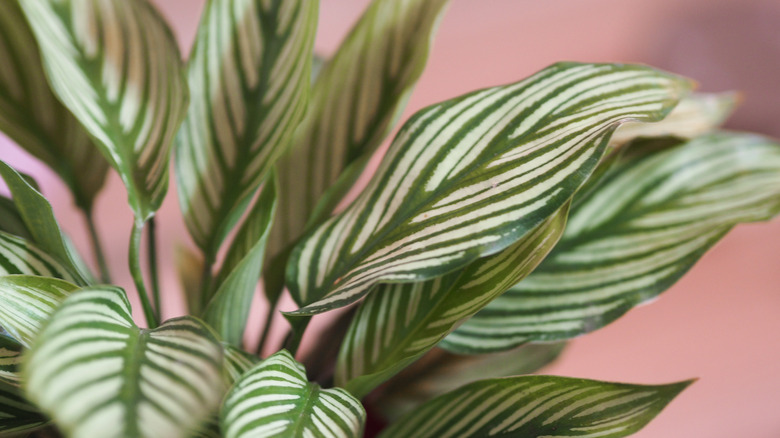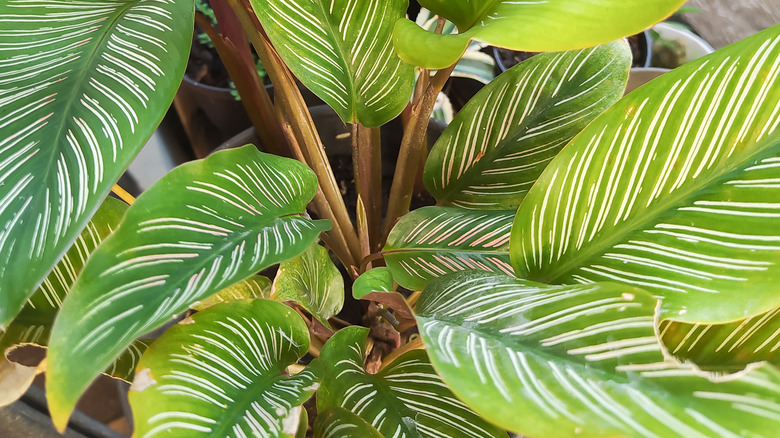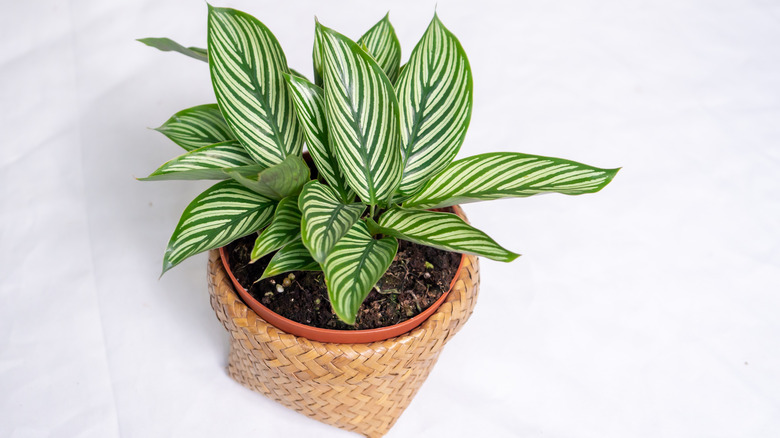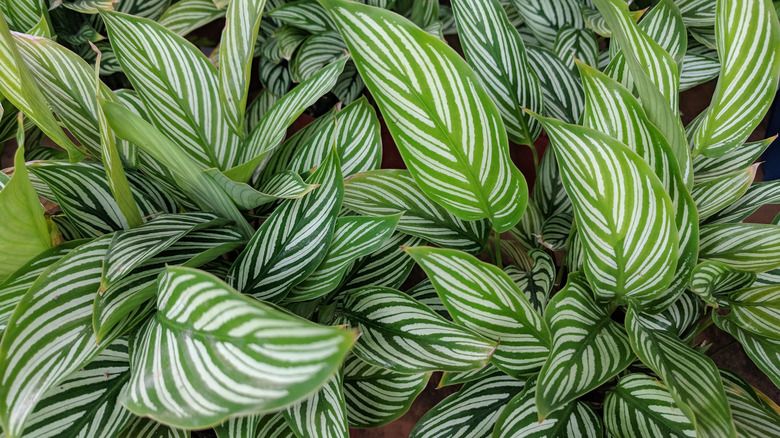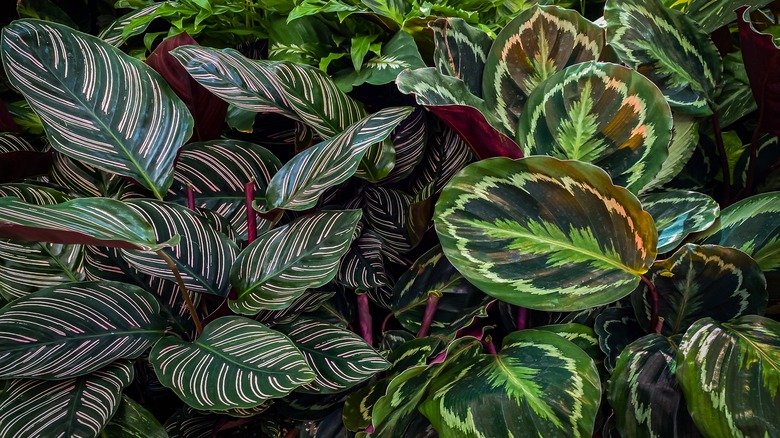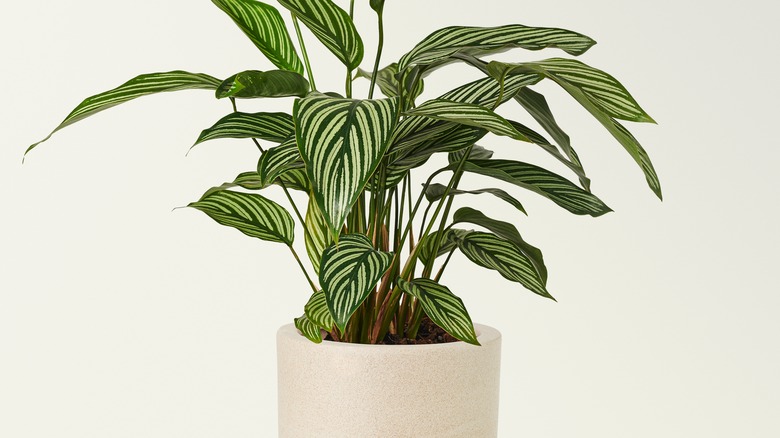Calathea Vittata: Everything You Should Know Before Planting
The calathea vittata is a member of the calathea genus, unique for its delicate, creamy-white, striped leaf variegation. The calathea genus comes from Brazil, and naturally thrives in tropical conditions (via The Spruce). As such, they have a tendency to be a slightly finicky, high-maintenance houseplant. The vittata variety is no different, requiring specific, strict humidity and lighting conditions to thrive. When these conditions are met, however, the plant will grow quickly and thrive, making a beautiful addition to your room.
The calathea vittata also boasts a variety of cool features and benefits. According to Gardening It, the calathea will open up its leaves in the morning and curl them up at night. The calathea vittata is also a smaller variety of its genus, only reaching 12 inches tall, which makes it ideal for a desk, side table, or other small surfaces, advises Seed, Soil and Garden. This plant is completely non-toxic to humans and animals. And finally, as reported by Air So Pure, the calathea genus is a great plant for air purification. Despite this plant's more regimented care needs, it is an excellent option for those ready to dish out just a little more TLC and reap the benefits of the calathea vittata.
How to use calathea vittata in garden
The calathea genus is native to a tropical environment. When considering if you should plant calathea vittata outside, there are a few obstacles to consider. These plants will only grow outdoors in USDA hardiness zones 11 and 12, which includes Southern Florida and Hawaii. According to The Spruce, calathea will grow best in temperatures from 70 to 85 degrees, and should never be exposed to temperatures colder than 60 degrees. Their natural light source usually comes from filtered light shining through the canopies of a tropical forest, and as such they prefer indirect, filtered light, and even shade. They should never be exposed to direct sunlight. Potted calathea vittata should not be brought outdoors during summer months, either.
It is not uncommon to plant decorative calatheas in the appropriate climate, though. According to Gardening Know How, calatheas make great border plants, as well as a taller, more dramatic ground cover. They can also be planted in clusters of other tropical plants, such as other calathea varieties, for a decorative landscaping accent — just provide at least 18 inches of space between plants. Additionally, the natural humidity should be sufficient to sustain the plant's needs.
Calathea vittata prefer slightly acidic soil. There are a variety of ways to acidify your soil, as found in this article from The Spruce, including the addition of sulfur, peat moss, aluminum sulfate, and more — all of which should be available at your local garden center.
How to grow calathea vittata
Growing your own calathea vittata through propagation is a surprisingly easy process called division. Calathea roots grow from root balls, and Osera says you can expect a healthy plant to grow new offshoots from the soil. Once these are grown a few inches tall, you can separate and propagate them.
According to Soil, Seed and Garden, the process is very simple and routine. Since you have to unearth your plant to separate its new growth, this process is best done during repotting. To begin, remove the plant from its pot and examine the root system. Gently break up the roots, and look for the root ball that connects to the offshoot. Very carefully separate this from the mother plant's root system with a clean knife or pair of gardening scissors. Repot the offshoot into a small pot. Repeat this for as many offshoots as you would like to propagate. Gardening It says you should expect to see roots around four weeks, mature roots around two months, and new growth anywhere from three to six months.
How to care for calathea vittata
Calathea vittata have a reputation for being a little difficult, but it is largely due to their rather strict set of care needs. These conditions are easy enough to meet, and largely reflect the plant's native tropical climate. According to Osera, you should avoid exposing your calathea vittata to bright, direct light, instead opting for medium light. They warn that low light will not be optimal for the plant's growth. Avoid southern facing windows, as their direct rays will likely burn the calathea's leaves. You should regularly monitor your plant's moisture levels — it shouldn't be left to dry out, and it shouldn't be overwatered. Water when the plant's surface soil is dry, preferably with filtered water.
Calathea vittata requires a humid environment to thrive. Bloomscape suggests routinely misting your plant, as well as using a pebble tray or humidifier. They also suggest keeping calathea vittata away from vents and windows, and fertilizing it monthly in the spring in summer.
Varieties of calathea vittata
Calathea vittata is not the only option for your next houseplant addition. A trip to your local plant store will show you the expansiveness of the calathea genus, all with varying visual appeals and attractive aspects. Here are just a few varieties of the popular varieties, according to Plant Care Today.
-
Calathea Lancifolia: Commonly known as the rattlesnake plant, this variety gets its name from its scaly leaf design, and sports maroon accents.
-
Calathea Roseopicta: This variety is unique for its bright pink accents, and is also known as the rose painted calathea.
-
Calathea Zebrina: Also known as the zebra calathea or zebra plant, this variety is distinguished by its bright, uniform stripes that contrast with its darker green leaves.
-
Calathea White Fusion: This stunning variety is known for its white, almost snowy leaf variegation and delicate purple accents.
-
Calathea Crocata: Most commonly known as eternal flame, this plant gets its nickname from its bright orange flowers, and enjoys more light than other members of the calathea family.
How to repot calathea vittata
Repotting calathea vittata isn't a regular task, and according to Soil, Seed and Garden, should only be done when you see the plant has outgrown its current pot — roughly every two to three years. Aim to repot your calathea vittata in the beginning of its growing season, roughly early spring.
Begin by removing the plant from its current pot and examining its root system. Remove any unhealthy roots. You can also separate offshoots for propagation at this point. Smart Garden Guide says you should prepare your plant's new pot with a soil mixture of potting mix and perlite, roughly 60/40, filling it only a couple inches. This pot should be an inch or two larger than its previous one. Add your plant to its new pot, and fill it up with the soil perlite mixture. Water lightly, but be careful to avoid waterlogging the plant's fragile roots. Do not fertilize your plant for the next month or so, as it may shock the root system and result in complications.
